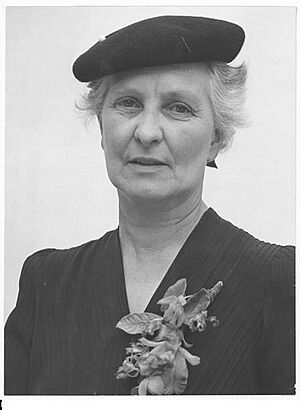Doris Blackburn facts for kids
Quick facts for kids
Doris Blackburn
|
|
|---|---|
 |
|
| Member of the Australian Parliament for Bourke |
|
| In office 28 September 1946 – 10 December 1949 |
|
| Preceded by | Bill Bryson |
| Succeeded by | Seat abolished |
| Personal details | |
| Born |
Doris Amelia Hordern
18 September 1889 Melbourne, Victoria, Australia |
| Died | 12 December 1970 (aged 81) Coburg, Victoria, Australia |
| Political party | Independent |
| Spouse |
Maurice Blackburn
(m. 1914–1944) |
Doris Amelia Blackburn (born Hordern; 18 September 1889 – 12 December 1970) was an Australian woman who worked to improve society and became a politician. She served in the House of Representatives from 1946 to 1949. She was only the second woman to do this, after Enid Lyons.
Doris Blackburn believed in socialist ideas, which means she thought society should be fair for everyone. She was first a member of the Labor Party. She was married to Maurice Blackburn, who was also a Labor politician. When her husband was removed from the party in 1937, she left the party to support him. After her husband passed away in 1944, she was elected to his old seat in 1946. She was the first woman ever elected to parliament as an independent (meaning she didn't belong to a major political party). She served one term and later became the president of the Women's International League for Peace and Freedom.
Contents
Early Life and Early Work
Doris Hordern was born in Hawthorn, Melbourne, Victoria. Her father was Lebbeus Hordern, an estate agent. Her mother was Louisa Dewson. From a young age, Doris was interested in women's rights and peace.
She worked as a campaign secretary for Vida Goldstein. Vida was the first woman to try and get elected to the federal parliament in Australia. Doris married Maurice Blackburn in Melbourne on 10 December 1914. He also believed strongly in socialist ideas. They spent their honeymoon organizing campaigns against war and against forcing people to join the army (called anti-conscription campaigns).
Her Political Journey
While her husband, Maurice, served in different parliaments, Doris continued to work on social issues. Sometimes her work caused disagreements with the Labor Party, which she was also a member of.
In 1937, Maurice was removed from the Labor Party. Doris then decided to leave the party to stand with him. Her husband continued to be a politician as an independent. However, he lost his seat in the 1943 election and passed away the next year.
Time in Parliament
Doris was unhappy with how the Labor Party treated her husband. So, she decided to run for his old seat of Bourke in the 1946 election. She ran as an Independent Labour candidate. When she won, she became only the second woman to be elected to the Australian House of Representatives.
In parliament, Doris Blackburn sat with other politicians who were not part of the main parties. She continued to support the same issues her husband had. She became well-known in 1947 for being the only politician to vote against the Atomic Energy Bill. This showed her strong belief in peace. She also served as the national President of the Council for Civil Liberties.
After some changes to the electoral map, her seat of Bourke was removed. In the 1949 election, she ran for a new seat called Wills. She came in third place, competing against both the Labor and Liberal parties. She tried again in the 1951 election for Wills but also came third.
Working for Change
Doris Blackburn remained very active in social issues after leaving parliament. She became the president of the Women's International League for Peace and Freedom. This group works for peace and women's rights around the world.
She also saw the problems faced by Aboriginal people after visiting the Woomera Rocket Range. Because of this, she helped start two important groups: the Aborigines Advancement League and the Federal Council for Aboriginal Advancement. She co-founded these groups with Douglas Nicholls. These organizations worked to improve the lives of Aboriginal people.
Later Life
Doris Blackburn passed away on 12 December 1970 in Coburg, Victoria. She was 81 years old. She had two sons and two daughters.
See also
- List of peace activists

